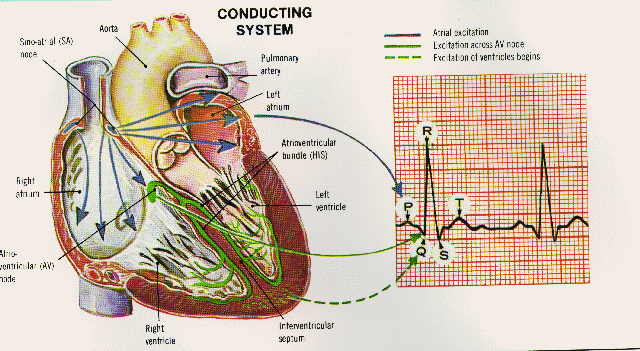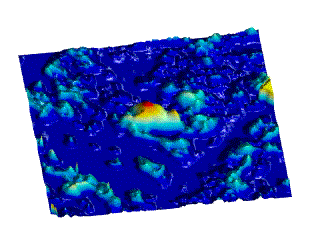Research (This page is badly out of date - Sorry!)
The scientist does not study nature because it is useful; he studies
it because he delights in it, and he delights in it because it is
beautiful. If nature were not beautiful, it would not be worth
knowing, and if nature were not worth knowing, life would not be worth
living.
- Henri Poincare
Great are the works of the LORD;
They are studied by all who delight in them;
Splendid and majestic is His work.
He has made His wonders to be remembered.
- King David
Mathematical Cardiology
The heart is a 4 chambered mechanical device designed to pump blood to
and from the body. Its contractions are regulated by an electrical
impulse called an action potential which conducts throughout the heart
muscle through the cardiac conduction system. The behavior of the
action potential is reflected in the body surface ECG
(electrocardiogram). Disruptions of
the normal conduction of actions potentials are called
cardiac arrhythmias.

Cardiac Arrhythmias
Jim Keener, Sasha Panfilov, Tim Lewis, Eric Cytrunbaum, Chung-Seon Yi,
Young Seon Li, Brad Peercy
Problems:
- To understand the dynamics of cardiac arrhythmias
- To understand the ionic mechanisms underlying onset of fibrillation
- To understand the mechanism of defibrillation.
 |
For an overview of graphical images see
Whole heart Pictures or
Tissue slab pictures .
For an overview of some of the research in the Math Biology group
here see these slides
Some Recent Lectures
- Flagellar
Length control
- Arrhythmias by Dimension
(AMS)
- The Dynamics of
Defibrillation - (SIAM Life Sciences Conference)
- The Onset of Fibrillation
following a Heart Attack (SIAM50)
Biofilms and Virulence
We are in the beginning stages of research into the behavior of
biofilms and the organisms that make biofilms, specifically
P. aeruginonsa. There is a lot that can be said about these
organisms, but for starters here are some web sites that give some
interesting information about biofilm infections, etc.
P aeruginaosa
and Cystic Fibrosis
Exotoxin
synthesis
Biofilms
in motion
Epithelial
attack
Here is a lecture that I have given on P. aeruginosa.
Recent Publications
- Three Dimensional Propagation in the Heart:
The Effects of
Geometry and Fiber Orientation on Propagation in Myocardium
- The Effects of Geometry and Fiber
Orientation on
Propagation and Extracellular Potentials in Myocardium
- Geometry Creates Spirals
- Direct Activation and Defibrillation of Cardiac Tissue
- Re-entry in an Anatomical Model of the Heart
- A Biophysical Model for Defibrillation of
Cardiac Tissue
- The Effect of Gap Junctional
Distribution on Defibrillation (no pretty pictures - sorry!)
- A Numerical Method for the Bidomain Model
in Cardiac Tissue(no pretty pictures here either - sorry!)
- The Biphasic Mystery: Why a
biphasic shock is more effective than a monophasic shock for
defibrillation (Nice pictures)
- Homogenization and Propagation in the
Bistable Equation
- Propagation of Calcium Waves in a Medium with
Discrete Release Sites
- Quroum sensing in P. Aeruginosa
- Immersed Interface Methods for Neumann
and Related Problems
- Diffusion Induced Oscillatory Insulin Secretion
Other interesting sites:
- Bioinformatics - University of Utrecht (Sasha
Panfilov - one of my collaborators)
- Computational EP - Duke University
- Bioengineering Research
Group - New Zealand
- Oslo group
- Computer Graphics - Utah
-
Bioengineering - Tulane
-
Applied Chaos Lab - Georgia Tech
- Dalhousie University
Students currently involved in this research effort include:
- Young-Seon Lee
- Bradford Peercy
- Nick Cogan
- Brynja Kohler
- Frank Lynch
- Stefan Folias
You too can become involved! Here's how:
- Group Meeting
-

Want to know about graduate study in Math Biology at University of
Utah?

This research is supported in part by grants from the National Science
Foundation. Thanks.
For more information contact J. Keener, 1-6089
- E-mail: keener@math.utah.edu



